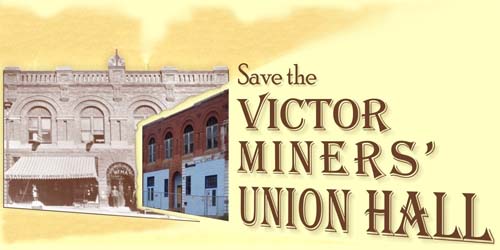 |
Victor
|
The
Pinkerton Labor Spy
by
Morris Friedman

CHAPTER IX.
THE CRIPPLE CREEK STRIKE—CONTINUED.
For over a month things were quiet in Teller County. The troops left the strikers alone, and contented themselves with loafing around the different camps. The miners were calm, orderly, and firmer than ever in their demands of fair play for the smeltermen.
This peaceful state of affairs continued until Nov. 16th.
During the night of Nov. 16th, 1903, someone loosened a rail on the Florence & Cripple Creek Railroad on a high embankment near the town of Anaconda, by removing the spikes that held the rail in place. This felonious act was committed shortly before the arrival of a train which carried a large number of both union and non-union men.
No wreck occurred, as Engineer William Rush had received a "tip" that a rail had been tampered with, and his informant even told him where the act had taken place. On the strength of this information the engineer stopped his train just before the fatal spot, made an examination, and discovered that sure enough one of the rails has been loosened. Engineer Rush reported the case to his company, and the company officials quickly gave this information to General Bell.
At last the military had some work to do. In a few hours they had arrested two men, Charles McKinney and P. H. Mullaney, whom they charged with the crime of unspiking the rail for the purpose of wrecking train No. 51.
General Bell, as usual, talked freely, and gave out the statement that he was prepared to protect his prisoners at all hazards, and that he would not hesitate to shoot the entire population of Colorado if they attempted to secure possession of the prisoners. We cannot comment on this statement, as we believe the General himself did not know what he was talking about when he made it.
We will go somewhat into detail concerning this case, because it has brought to light the interesting probability that the Mine Owners' Association actually hired men to loosen the rail on the Florence & Cripple Creek Railroad, and then had some one give Engineer Rush a tip as to the impending calamity. Their object in playing this comedy was, to turn it into a tragedy for the Western Federation of Miners by accusing that organization of having plotted to wreck a train, so that the stigma of attempted train-wrecking would entirely discredit the Miners' Union with the public.
This was undoubtedly the object of the mine owners, for they caused Thomas Foster, Sherman Parker and W. F. Davis, three of the most prominent executive leaders of the Federation in the district, to be arrested and indicted for this offense. The mine owners and General Bell were loud in their boasts that they had evidence sufficient to convict, and they were backed in their assertions by Detectives D. C. Scott and K. C. Sterling, both in the employ of the railroad and the Mine Owners' Association.
The miners investigated the case so thoroughly that when it came up for trial they not only absolutely vindicated their leaders, but fastened the crime on the right parties; but as these parties were no other than Detectives Scott and Sterling," the case was never prosecuted.
Victor Maher, a butcher in the union store at Victor, testified that he happened to be out late the night of the attempted derailing, and that he passed the place while the rail was being loosened. He claimed that he saw Detective Scott and a short, heavily-built man do the work. The witness was asked to identify Scott among the crowd in the court room, and, while pointing an accusing finger at the tool of the mine owners, he said, "THIS IS THE MAN NOW STANDING UP THAT I SAW WITH A BAR IN HIS HAND, OR A PIECE OF STEEL."
Engineer Rush's evidence was still more damaging. The engineer stated that a day previous to the attempted wrecking, he was approached by Detective Scott, and asked where there was a good place to derail a train. According to engineer Rush's testimony, Detective Scott suggested one point, but he, the engineer, suggested another place, about 200 yards farther south. When questioned by counsel as to which place was chosen for the derailing, the engineer said, "YES, IT WAS AT THE VERY PLACE THAT I SUGGESTED."
The evidence of Charles McKinney, state's evidence and star witness, created a sensation.
It was brought out that he had been a member of a gang of cattle and horse thieves operating on the line between Kansas and Nebraska, and that he had fled from there for fear of landing in the penitentiary. After coming into the Cripple Creek district he was known under various aliases.
It appeared that McKinney was a mental degenerate, and that the Mine Owners' Association took advantage of this fact by having him sign confessions wherein he implicated Foster, Parker and Davis in a plot to wreck the Florence & Cripple Creek train, and stating besides the amount of money they had agreed to pay him for his deed.
The reader can form an opinion as to McKinney when we state that he also made and signed confessions which he gave to counsel for the Western Federation, wherein he stated that he did not know anything about the crime with which he was charged; that the men he accused were innocent, and that the confessions he had made were written by him at the instigation of Detectives Scott and Sterling.
Counsel for the Federation also produced a letter McKinney had written in jail to his wife, wherein he exonerated the union prisoners. While these conflicting confessions were of themselves sufficient to invalidate his testimony, McKinney nevertheless attempted to square himself by stating that all his confessions were false, excepting the ones he had made to Detectives Scott and Sterling.
When cross-examined by counsel he said he would do the same kind of a job for $250.00; that he had attempted several times to wreck a Florence & Cripple Creek train; that the union had plotted everything; and that he would wreck a train or commit most any kind of a crime for money.
After staying out for thirty minutes the jury returned a verdict of not guilty for Foster, Parker and Davis.
The attempted derailing of F. & C. C. train No. 51 is a remarkable case, as it proves that organized capital will go to any lengths to crush organized labor. Let us make a little analysis of the case.
The train in question carried a great number of union miners, as well as non-union men. What good would it have done the Federation to commit such a frightful crime in the first place, and in the second place, is it possible that the Federation would have murdered a number of its own members just for the sake of killing some non-union men? There might have been some little ground upon which to base such an accusation if Governor Peabody, General Bell, Manager MacNeill, Secretary Hamlin of the Mine Owners' Association, or some other person very obnoxious to the miners had been on that train.
There was therefore no visible motive that could have prompted the Federation to authorize the commission of such a fiendish deed, and no one knew better than the Federation officials that violence of such a character would only arouse public sentiment against them, and serve as an excuse for the most extreme measures by the military.
Again, the testimony brought out at the trial proves beyond the shadow of a doubt that the Mine Owners' Association conspired to destroy the reputation of the Western Federation of Miners by levelling the charge of train-wrecking against their leaders. It is possible that if the association had chosen more skilled tools their plot would have carried, enabling them to send three innocent men to the penitentiary.
McKinney was an idiot, pure and simple; and their detectives, Scott and Sterling, were clumsy bunglers. Had they been in the employ of the Pinkerton Agency, they would have been discharged at once for their awkward work. Scott committed a serious indiscretion in asking engineer Rush to designate a good place for derailing the train.
The tip that the engineer got as to the impending catastrophe, clearly demonstrates that it was the object of the Mine Owners' Association to humiliate and discredit the Federation, but not to cause a wreck and loss of life. The fact that the rail was unspiked at the very place suggested by engineer Rush to Detective Scott, indicates that either Scott did the work himself or instructed some one else to do it. The evidence of Victor Maher, who was an eye witness to the unspiking of the rail, proves conclusively that Detective D. C. Scott with another man, possibly Detective Sterling, actually did the work.
A brave and impartial jury rendered justice. Yet, notwithstanding that the verdict of the court was in favor of the Federation, the Mine Owners' Association, State administration, the military and the Pinkerton Agency kept on insisting that this crime was the work of the INNER CIRCLE of the Western Federation of Miners, and to this day the Federation remains charged with it.
We have analyzed this case with a purpose in view; namely, to show that the public must be careful, in the future, about believing the official statements of the blue-blooded Anarchists known as mine owners, trust magnates, smelter officials, et al. If the mine owners stooped to conspire with a degenerate like McKinney against the liberty of three men and the fair name of thousands, we have a right to doubt any further statements or charges made by this unscrupulous band.
During the time of the troubles in the different mining camps, the Mine Owners' Association censored all newspaper accounts of the doings of the military in the alleged rebellious districts, and only allowed such news to be printed as was adverse to the miners.
The Rocky Mountain News, of Denver, which refused to be muzzled, was boycotted by the different monopolies, and forced to put up a strong fight for the right to print news as it occurred.
The courts were insulted, threatened, humiliated and abused by the military.
In view of all these facts, we now ask: Is it not possible, aye probable, that the subsequent trouble in the Cripple Creek district, namely the Vindicator explosion and the terrible explosion at the Independence depot, was the deliberate work of tools of the Mine Owners' Association, and not of the Federation?
Is it not possible, or rather probable, that the long list of crimes with which the Federation has been charged during the last ten or twelve years is made of the same cloth as the lying accusations and charges which were disproved in the Cripple Creek district?
Is it not more than probable that the alleged confession which James McParland, of the Pinkerton Agency, secured from convict Harry Orchard, and upon the strength of which he would like to hang President Charles Moyer, Secretary-Treasurer William D. Haywood and George A. Pettibone, of the Western Federation of Miners, for the murder of ex-Governor Steunenberg of Idado, is on a par with the confession of Charles McKinney?
Let the reader judge for himself for the present. We will soon study and analyze those matters.
Chapter X. The Cripple Creek Strike (Continued).